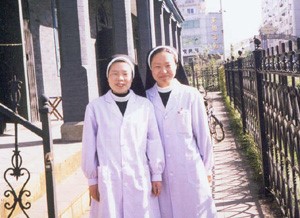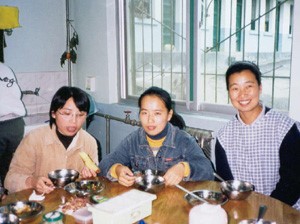
China Bridge (神州橋樑)_2003/Nov
Sisters in China Today
Recently, I accompanied the director of the Hilton Foundation Funds for Sisters on a trip to China. She was eager to visit various groups of sisters to teach them how they could apply for money to meet some of their most basic needs.
Visiting the sisters in China
The first stop in our itinerary was Xi’an, Shaanxi Province. After visiting Bishop Li Duan and explaining the reasons for our visit, we met with the sisters and visited their various works. We repeated this routine over and over with the sisters in Beijing, Shijiazhuang, Shenyang, Jilin, Fushun, and Shanghai.
Approved works for Sisters

We soon found out that although the government welcomes the work of the sisters, it also places certain strictures on the kinds of work they can undertake. This means, of course, that we visited similar works wherever we went.
Sisters are allowed to run kindergartens, but they are not allowed to engage in formal education beyond that level. The Communist government feels that early education is one of the most powerful avenues for influencing the mind, and so thus far, elementary and secondary schools are not permitted.
We visited numerous clinics, and homes for the elderly. Sisters also do pastoral work going to the villages to visit the people to teach them catechism. Others work within the convent making church vestments. In a few rare cases, an individual sister may work in publications as in the Faith Press in Hebei and in Shanghai, the sisters have been put in charge of the crematorium!
The Sisters Formation Centre
The sisters themselves as well as religious visiting from outside quickly grasp the need for Sisters to be instructed in the basics of their religious life and vocation. Bishop Li Duan of Shaanxi has responded to this need by setting up the Sister Formation Centre. This is an impressive undertaking. The Centre currently has 95 Sisters from 17 provinces enrolled in its programme.
We arrived in time to visit two classes: one on religious vows and another on leadership training for religious communities. Here, as in all other places, Sister Joyce carefully outlined the plan for securing needed funds.
Visit to the leprosarium

The bishop was kind enough to let us have his driver and his car so that we might go to a mountain area where a Korean priest, with donations mostly gotten from Korea, has established a leprosarium. Presently, there are 30 lepers there who have been cured, but who are in need of a home, food, and personal medical attention. There are also 10 new leper cases.
The priest has recruited two Korean sisters to work at the Centre. Since leprosy still carries a terrible stigma in China and few people are eager to work with lepers, the government seems happy to have persons, wherever they come from, willing to help to relieve them of a burden they are not able to bear.
Besides a few hired staff, the leprosarium, runs completely on volunteer services. Some of the young women volunteers were originally members of religious communities.
These young women are very impressive. They live a truly religious life of community, prayer and poverty. They have no designated leader and get no remuneration whatsoever for their services. Occasionally, they are given a small amount of pocket money, not even sufficient to buy a new piece of clothing. At present, they seem to rely almost totally on their families for their personal needs. It is difficult to see how they will be able to sustain this for any length of time, yet they are faith-filled and relying totally on the providence of God.
An unexpected gift
One of the volunteers told us that last February, the leprosarium had exhausted all its available funds. They had no idea how they would be able to feed the lepers. Suddenly a stranger arrived at the leprosarium and laid RMB 80,000, on the table, an amount sufficient for two months, and then he left. It is no wonder that they have put their trust in the providence of God!
Continuing the journey

While in Beijing we took the opportunity to visit the new diocesan seminary and spoke at some length with Father Matthew Zhen, the rector. Father Matthew spent four years with the Benedictines in Collegeville, Minnesota before being assigned to this post. He spoke of the serious problem China is experiencing with priests leaving their ministry. Some he said, leave for more lucrative work after they have received a good education, others are influenced by the increasing secularisation of Chinese society; some are unable to cope with the age gap in the clergy that results in serious misunderstandings between the young and old and although some are still affected by the division in the church, younger priests are eager to find ways to solve the division. One condition that does not find an immediate solution and that paralyses the young priest is loneliness. Part of this is due to celibacy, but in China, where young men are often isolated in rural areas and work may not be plentiful or satisfying, the life of the diocesan priest can be very lonely. Unless they get strong support from their peers and the older men, they easily get lost.
We left Beijing for Shijiazhuang, Hebei Province. To save time and to make as many connections as possible, we had asked to meet with the Conference of Major Superiors in the area, one of the very few in China. The young sisters were all eager to share their needs in view of being able to give better service.
In addition to the usual works, Shijiazhuang also boasts of being the home of the Faith Press that has a circulation of some 50,000 and Beifang Jinde, the social service arm of the diocese.
From Beijing we made our way to Shenyang, Jilin and Fushun to continue our visits with the sisters and then on to Shanghai.
The sisters’ living situation
Most convents in China are more or less the same. They are poor, colourless, unattractive, dreary, airless, grey structures. Often they are relics of former minor or major seminaries or crumbling parish structures. They seem to provide little in the way of inspiration, beauty or comfort. The weather at the time of our visit was already cold, but there was no heating in any of the places we visited. Sisters ate and attended classes wearing their winter coats.
Shanghai revisited
I had not been in Shanghai since 1991. The changes are nothing short of awesome. Business is booming, skyscrapers are rising everywhere and the city seems to be quickly regaining the cosmopolitan atmosphere for which it was so famous in the past.
The generational gap
All sisters’ congregations in China are under the local bishop. A few have a history of originally being part of an international community. The rest were generally founded in the 1930s and re-founded between 1985-1989 following the Cultural Revolution (1966-1976) and the re-opening of China to the world. The gap produced by the time lag, and especially the occurrence of Vatican II during that time, has created a terrible generational gap in the understanding of the Church and of religious life.
Needs for holistic development
The sisters presented the following as their most pressing needs: basic education, religious formation in the vows, community living, spirituality. They voiced the need for library materials that include both secular and religious works. They mentioned that computers would be helpful to access the Internet and that would help broaden their experience of the outside world and allow them to benefit from the flow of information.
Needs related to works
In relation to their works, the sisters felt the need for more attractive surroundings and materials for the children. In their homes for the elderly that often house and care for nearly 100 elderly men and women, they feel the need for machines to facilitate their work. Often they have only one small washing machine and no dryer for such a large group of elderly people.
Conclusion
The situation in China is not without hope. Young, talented and dedicated women of goodwill are leaving their families and giving up marriage in large numbers to embrace the religious life and live in conditions of poverty. Those educated abroad have profited from the experience and are eager to pass on their knowledge to others. All the sisters we met were hospitable, projected a joyous spirit and a ready smile. For sure with their ingenuity, they will find ways, through their poverty, to capitalise on what they have, to maximise their strengths and achieve wholeness and holiness. The future is theirs and in China as in so many other places in the world, the Sisters are the hope of the Church.


 ENG
ENG